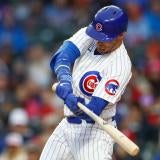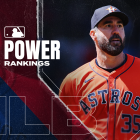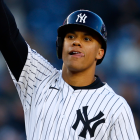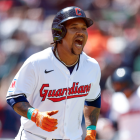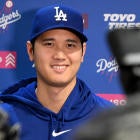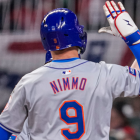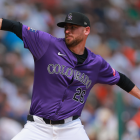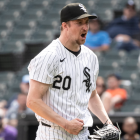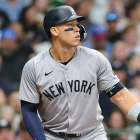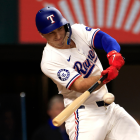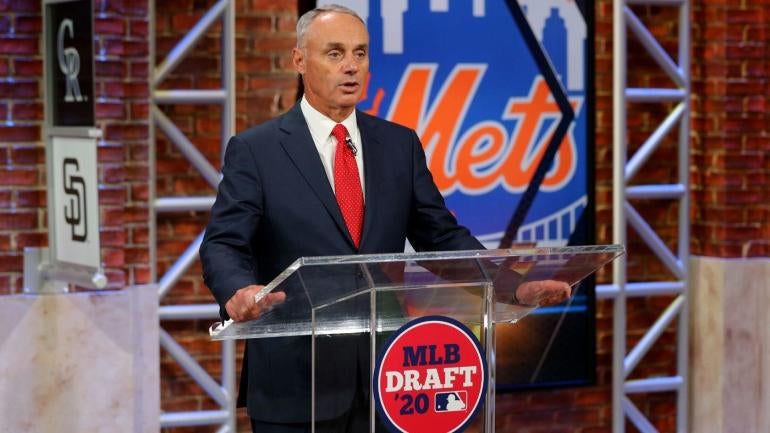
The 2020 Major League Baseball amateur draft wrapped up Thursday night. The two-day, five-round event took place this week, with the Detroit Tigers making Arizona State slugger Spencer Torkelson the No. 1 pick. The Tigers added the best all-around offensive talent in the country to their pitching rich farm system.
"Our decision to select Spencer was a clear one," Tigers GM Al Avila said about Torkelson, a career .337/.463/.729 hitter with 54 home runs in 129 games with the Sun Devils. "He's exactly the type of player we hoped would be there for us to get with the top pick. Obviously, one of the most productive hitters in college history."
The MLB draft is about long-term impact -- there are a few pitchers in this draft who could be part of a 50-man roster this summer, though this is a weird season -- rather than instant gratification. Even the best draft prospects spend years in the minors. As such, it is kind of foolish to declare draft winners and losers right away. It is an exercise in futility.
That's never stopped us before, of course, and it's not going to stop us now. With the draft complete, we're going to hand out grades for each team's haul. Mike Axisa handled the American League and R.J. Anderson covered the National League. You can find what you need to know about every 2020 first-round pick here. Below are our draft grades for every club.
Grade: B Arizona selected pitchers with its first three picks, adding Duke's Bryce Jarvis, Miami's Slade Cecconi, and prep lefty Liam Norris to the fold. Jarvis and Norris both had huge springs before the pandemic ended their seasons, and Cecconi has tantalizing size and stuff. It's up to the Diamondbacks' player development staff to ensure each fulfills their potential as a starter. | |
Grade: C The Braves had only four picks all draft. They started well, taking Wake Forest left-hander Jared Shuster in the first round. Shuster saw his stock improve as much as any pitcher over the last year, and now features a power fastball and above-average changeup. Their other notable pick was Michigan outfielder Jesse Franklin, who did not play this season due to a broken collarbone. | |
Grade: C Confusing draft for the Orioles. They used the No. 2 pick on slugger Heston Kjerstad, our No. 17 prospect, and it appeared they would sign him below-slot and use the savings on a top high school talent that fell to one of their later picks. The O's instead took safe-ish college hitters in Competitive Balance Round A (Jordan Westburg) and the second round (Hudson Haskin). It wasn't until the fourth and fifth round, when they popped high schoolers Coby Mayo and Carter Baumler, that the other show dropped. Good players, all of them, but the Orioles held the No. 2 pick and didn't land a truly elite prospect. Feels like they could've had a very similar draft with the No. 15 pick. | |
Grade: C The Red Sox surrendered their second-round pick as punishment for the sign-stealing scandal and that gave them a small bonus pool. Selecting high school infielder Nick Yorke was the surprise of the first round, though Boston did balance it with slugger Blaze Jordan in the third round. Jordan has big power and was viewed as possible early second round pick at times this spring. The Red Sox were always going to be behind the 8-ball because the were missing a pick. All things considered, they did fine. | |
Grade: B Shortstop Ed Howard was the Cubs' first-round pick. He's about as certain as a prepster can be to remain at the position, though it's to be seen how much he hits against better competition. From there, the Cubs chose college reliever Burl Carraway, who has a massive fastball-curveball combination, but isn't always able to locate. Carraway could pitch in the majors this season. Third-round outfielder Jordan Nwogu is a high-grade athlete who hits the ball hard and could be a dynamic offensive player with some fine-tuning. The Cubs also took Luke Little, a large lefty from a junior college who garnered attention online by topping 100 mph in throwing sessions during the pandemic | |
Grade: A It is essentially a two-player draft for the White Sox but they are two really good players. Lefty Garrett Crochet (first round) and righty Jared Kelley (second round) were consensus top-20 talents -- Kelley looked like a potential top-10 pick at times prior to the shutdown this spring -- and are potential impact players. Crochet could join the 50-man roster and pitch in the big leagues this summer. The White Sox had to go cheap with their third-, fourth-, and fifth-round picks to ensure they can sign Crochet and Kelley, but that's fine. Two top-20 talents in a five-round draft is a big win. | |
Grade: C The Reds used their first-round slot, No. 13, on Austin Hendrick, a prep outfielder with an explosive swing and star potential. Afterward, the Reds took bets on right-handers Christian Roa and Bryce Bonnin and catcher Jackson Miller. The Reds have invested a lot into their pitching development in recent years, so they have a chance to make this class look a lot better than it does on draft night. | |
Grade: B Good value throughout for the Indians. First rounder Carson Tucker was a hot name leading up to the draft and he's a potential impact shortstop at the next level. Competitive Balance Round A pick Tanner Burns was one of the best and most accomplished pitchers in the draft class, and second rounder Logan Allen is exactly the kind of pitcher the Indians tend to take to the next level through player development. Cleveland is really corning the market on Logan Allens (Logans Allen?). | |
Grade: A The Rockies landed three players on our top 50: outfielder Zac Veen, catcher Drew Romo, and right-hander Chris McMahon. Veen could mature into a middle-of-the-order hitter; Romo a defensive-minded reserve or second-division starter; and McMahon either a three-pitch starter or reliever, depending on what his body permits. Landing Veen and McMahon where they did makes this a fine haul. | |
Grade: A The Tigers held the No. 1 pick and they locked themselves into an A when they used it on Torkelson, a future middle-of-the-order anchor. They then added a very good all-around catcher in second rounder Dillon Dingler, a consistent college performer in outfielder Daniel Cabrera in Competitive Balance Round B, and they flat out stole Arizona State infielder Gage Workman in the fourth round. Workman was seen as a possible first-round pick coming into the season. Torkelson was arguably the best player in the draft and Detroit added three other late first round/early second round talents in Cabrera, Dingler, and Workman. Great, great draft for the Tigers. | |
Grade: C The Astros didn't have much to work with. They surrendered their first- and second-round picks as punishment for the sign-stealing scandal -- their first pick was No. 72 overall -- but they still landed a second-round talent in righty Alex Santos. Third rounder Ty Brown was a nice get as well. He is a stathead fave thanks to big spin rates. There's impact potential there, even if he's only a reliever. Houston did about as well as it could've hoped, but no first and second rounders is going to hurt no matter how you cut it. Hard to go higher than C in their situation. | |
Grade: A Asa Lacy, the top pitcher in the draft class, slipped out of the top three and into the Royals' lap with the No. 4 pick. That's a huge win. Kansas City then added maybe the best true shortstop in the draft class in Nick Loftin in Competitive Balance Round B, and second rounder Ben Hernandez might have the best changeup among high school pitchers in the draft class. Outfielder Tyler Gentry was a nice get in the third round too. Lacy makes this an A all by himself. Adding Loftin and Hernandez (and Gentry) on top of him is icing on the cake. | |
Grade: B The pitching-needy Angels selected Louisville lefty Reid Detmers, arguably the most MLB ready pitcher in the draft class, in the first round. There's a chance he'll join their 50-man roster this season. Third rounder David Calabrese has high-end tools and was seen as a possible tough sign, but I assume the Angels know they can sign him if they selected him. The Halos gave up their second rounder to sign Anthony Rendon, so they were short a pick, but Detmers and Calabrese make this a pretty good haul. | |
Grade: B Each of the Dodgers' first three picks were college arms, beginning with Bobby Miller and extending to Landon Knack and Clayton Beeter. (The Dodgers don't get extra points for fun names, but they could.) L.A.'s draft could look better or worse in a few years' time depending on their ability to help those arms remain in a rotation. Beeter, whose spin rates were better even than Asa Lacy's, has been identified as a potential steal. | |
Grade: A The Marlins started their draft with a surprise, selecting Minnesota right-hander Max Meyer with the No. 3 pick. That turned out to be a preview of what was to come, at least in the sense that Miami then chose three other arms with premium stuff: Dax Fulton, Kyle Nicholas, and Zach McCambley. Those last three each carry significant risks -- Fulton underwent Tommy John surgery last year; Nicholas and McCambley could end up in relief -- but there's ample reward here if the Marlins' player development staff can work some magic. | |
Grade: A The Brewers essentially took what they were given, and what they were given early on was a pair of potentially undervalued collegiate hitters: UCLA outfielder Garrett Mitchell and Miami shortstop Freddy Zamora. Mitchell has star potential if the Brewers can help him tap into his raw power, and Zamora could be a solid starter provided he recovers from a torn ACL. The Brewers also tapped catcher Zavier Warren. He'll need to be coached up, but the chance to be a good get as well. | |
Grade: C The Twins have emphasized college hitters with big-time track records in recent years and that trend continued this year. First rounder Aaron Sabato is an exit velocity god and second rounder Alerick Soularie has good bat-to-ball schools. Sabato and Soularie can hit, but they also come with defensive questions. The Twins traded their Competitive Balance pick to the Dodgers in the Kenta Maeda deal and they forfeited their third rounder to sign Josh Donaldson, so they were short on picks and pool money. | |
Grade: A The Mets draft boils down to signing three players: outfielder Pete Crow-Armstrong (a defensive dynamo and potential leadoff hitter); right-hander J.T. Ginn (a possible top-10 pick before he blew out his elbow this spring); and outfielder Isaiah Greene (another centerfielder with power potential). Each has the chance to provide the Mets with a ridiculous return on investment relative to where they were selected. Say what you will about the other aspects of Brodie Van Wagenen's bold approach to running a team, but it makes for exciting draft classes. | |
Grade: C The Yankees forfeited their second- and fifth-round picks to sign Gerrit Cole, so they had three picks and the second smallest bonus pool this year. They landed a first-round bat in Austin Wells with the No. 28 pick, but he might not remain at catcher long-term, which would take a bite out of his value. Third rounder Trevor Hauver has a chance to carve out a career as a versatile super utility type. With limited resources, the Yankees did about as well as they could've hoped. | |
Grade: B There was talk prep catcher Tyler Soderstrom would go in the top 10 in the days leading up to the draft, but the Athletics were able to nab him with the No. 26 pick. The rest of their picks, including second-round righty Jeff Criswell, were solid yet unspectacular. Getting Soderstrom near the end of the first round was a win. None of their other picks really stand out. | |
Grade: B The Phillies hit a home run by landing prep right-hander Mick Abel in the middle of the first round. He has all the makings of at least a mid-rotation starter, albeit one who will require developmental time. Their other notable pick was third-round shortstop Casey Martin. He has first-round tools, but slipped because of poor pitch recognition and a glove that's likely to land him in center field when it's all said and done. This class is high on risk, and high on reward. | |
Grade: A Pittsburgh kicked off its draft by taking Nick Gonzales, who will ostensibly end up at second base. There are some concerns about his power potential, but the Buccos were just out of range to grab one of the top five players in the class. After Gonzales, the Pirates went to the mound early and often, popping a trio of athletic arms, in Carmen Mlodzinski, Jared Jones, and Nick Garcia. Gonzales, Mlodzinski, and Jones all ranked in our top 50. | |
| Grade: A The Cardinals used their first three picks to swing from the heels for ceiling. That meant they chose prep third baseman Jordan Walker (a large lad with big power potential); prep shortstop Masyn Winn (a dynamite athlete with near-elite bat speed); and prep right-hander Markevian "Tink" Hence (a smaller pitcher with a fast arm and the ability to spin the ball). Each has the tools to become a high-grade contributor. That makes them worth the risk given where they were picked. | |
Grade: B The Padres had known to be enamored with prep outfielder Robert Hassell, so popping him at No. 8 didn't come as a shock. If he proves to be as good as they think, he'll be well worth the pick. After Hassell, the Padres took some chances. Prep right-hander Justin Lange has a big arm and a project; outfielder Owen Caissie has good raw power; and collegiate right-hander Cole Wilcox has the frame and stuff to start, though there are questions about his command and, ultimately, his signability. If the Padres can ink all four, they should be pleased. | |
Grade: C The Giants had five picks in the top 100, and they used four of them on college players. That started with catcher Patrick Bailey, whose boosters believe could feature four average or better tools at maturation. It continued with powerful third baseman Casey Schmitt; potential three-pitch lefty Nick Swiney; and infielder Jimmy Glowneke. You could argue a team in San Francisco's position should have been more aggressive in swinging for ceiling, rather than mostly playing it safe for floor. | |
Grade: A Georgia righty Emerson Hancock was viewed as a possible No. 1 pick candidate coming into the spring and the Mariners were able to get him with the No. 6 selection. That's pretty much the best-case scenario. Outfielder Zach DeLoach (second rounder) and righty Connor Phillips (Competitive Balance Round B) were good values. Phillips in particular is viewed as someone with untapped potential. Hancock alone earns an A. Everyone else is gravy. | |
Grade: A Upside upside upside. The Rays had an extra pick and extra bonus pool money, and they landed a premium arm in Nick Bitsko in the first round. He could've gone in the top 10 on talent but instead lasted to the No. 24 selection because his high school did not play any games prior to the shutdown, and he was underscouted. Competitive Balance Round A pick Alika Williams is a great up the middle athlete and third rounder Hunter Barnhart is a two-sport guy with a live arm. Now that he's focused on baseball full-time and in a great pitcher development organization, he could explode as a prospect. The Rays draft as well as any team and they did it again this year. | |
Grade: D The Rangers have a knack for going off the beaten path and they did it again this year. First rounder Nick Foscue can really hit, but he came off the board about half-a-round earlier than expected. Second rounder Evan Carter, a high school outfielder from Tennessee, was not among Baseball America's top 500 (!) draft prospects. Talk about a surprise pick. Third rounder Tekoah Roby has an interesting enough arm. The Rangers zig when everyone else zags. Nothing wrong with that, but it makes it tough to evaluate. | |
Grade: A Vanderbilt's Austin Martin was the No. 1 prospect in the draft class and the Blue Jays landed him with the No. 5 selection. They have to be over the moon. Toronto could have used its remaining picks on potted plants and Martin alone would've made this an A draft, but they also landed a fringe first round arm in second rounder C.J. Van Eyk, a riser with the spin rates analytically inclined teams love. Fourth rounder Nick Frasso could've been a second rounder had he not gotten hurt prior to the shutdown. Van Eyk and Frasso are two excellent complementary picks to Martin. | |
Grade: B The champions went college-righty-heavy, taking Oklahoma's Cade Cavelli, LSU's Cole Henry, and UCLA's Holden Powell. Cavelli and Henry could pitch in the middle of a rotation if they can stay healthy, while Powell has late-inning potential. The Nationals also popped prep shortstop Samuel Infante, who profiles as at least a spare infielder. | |








































